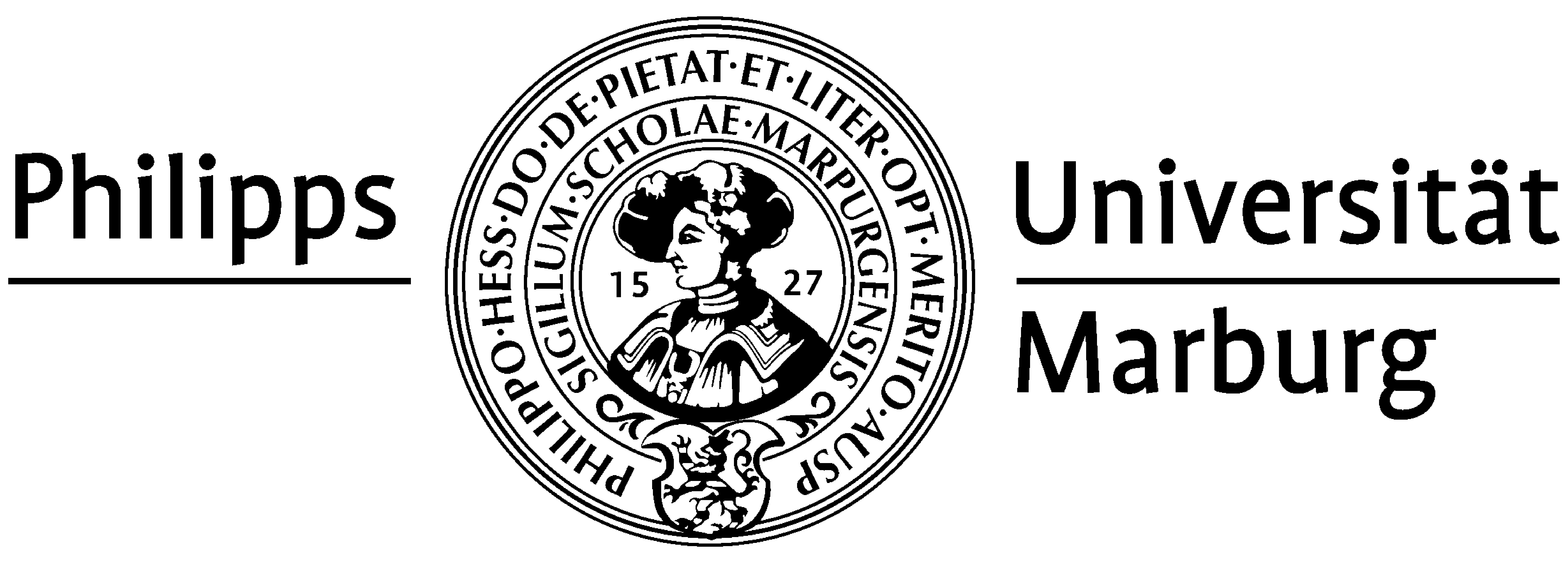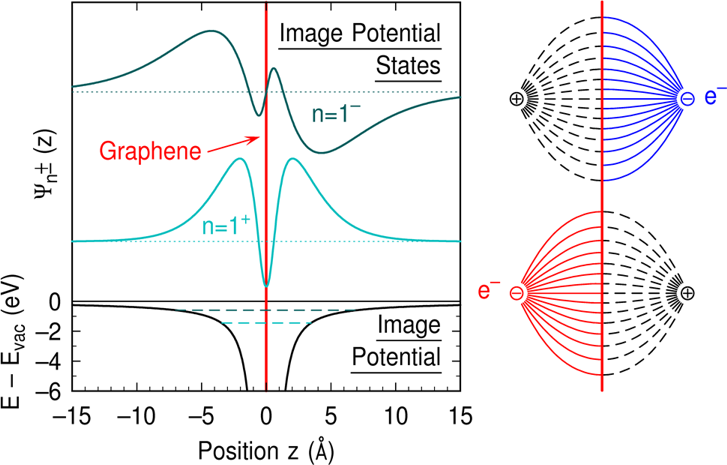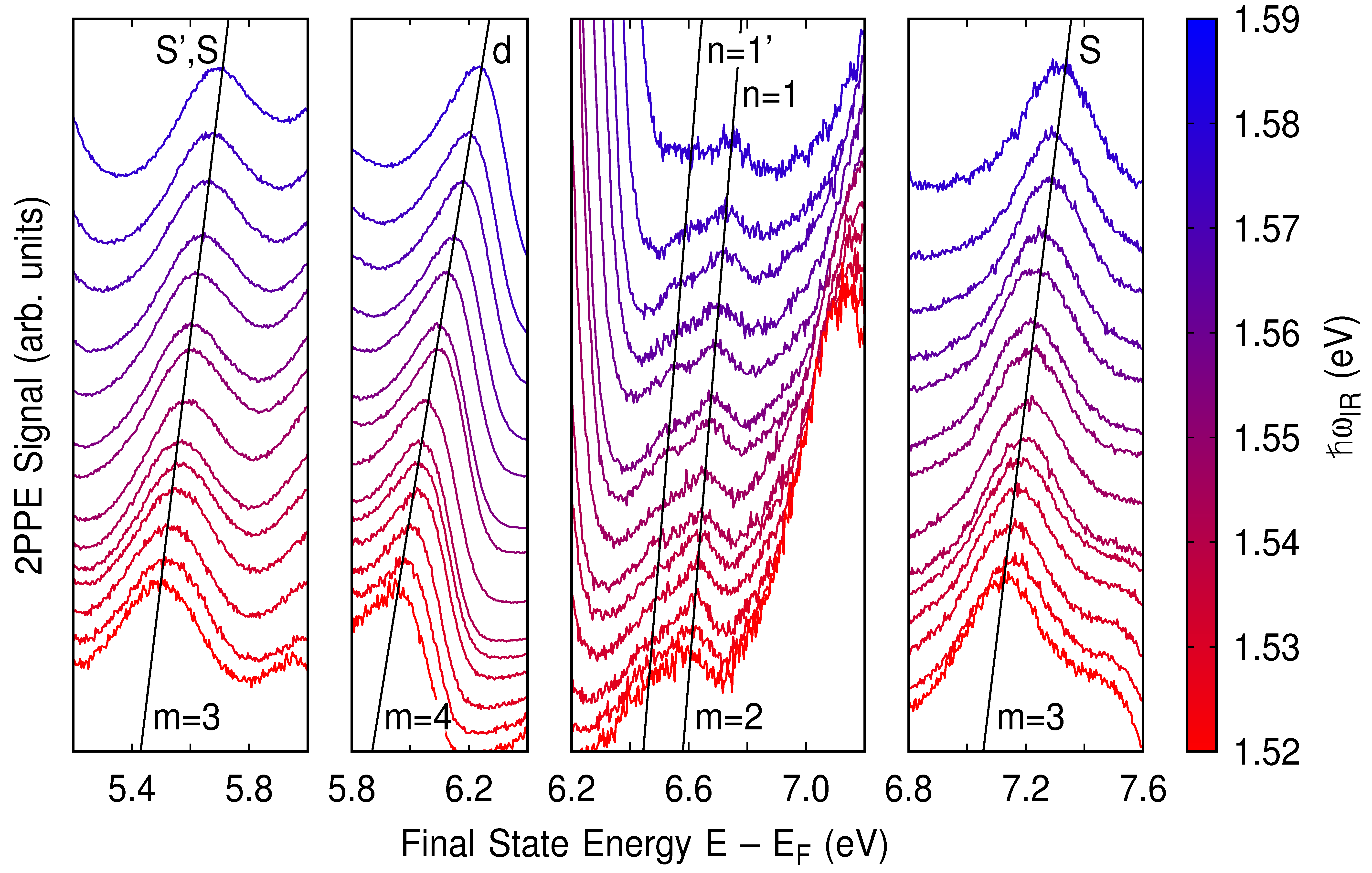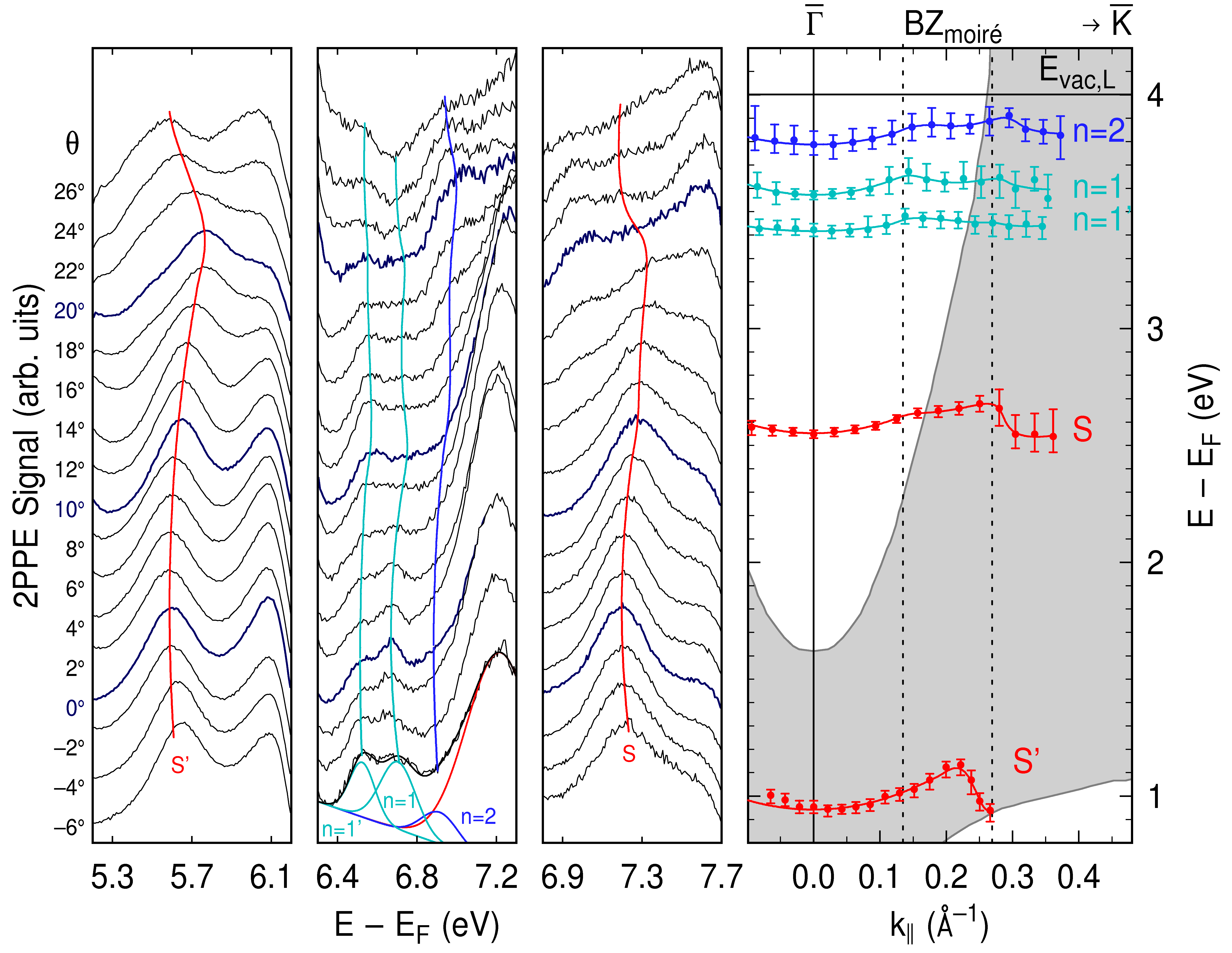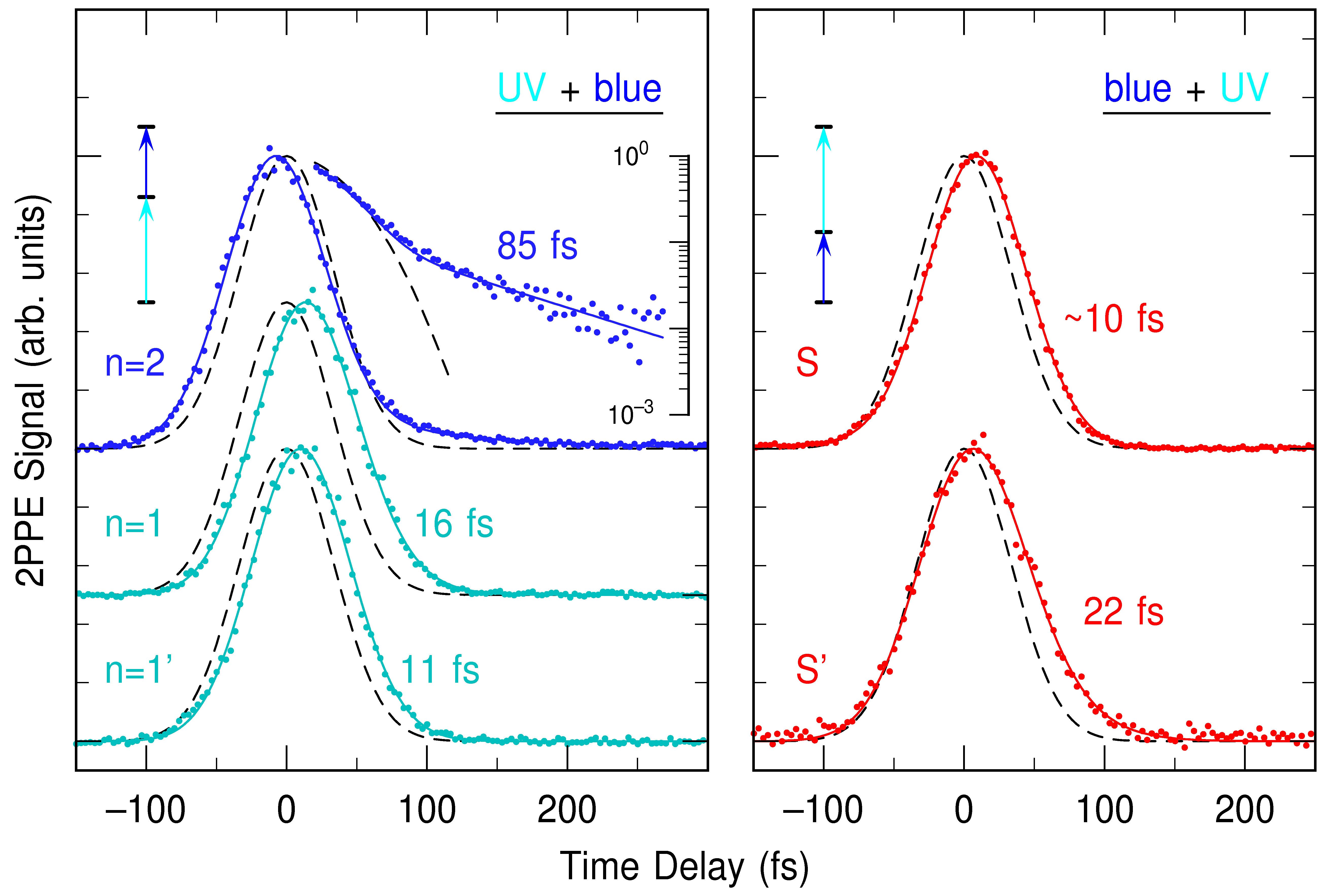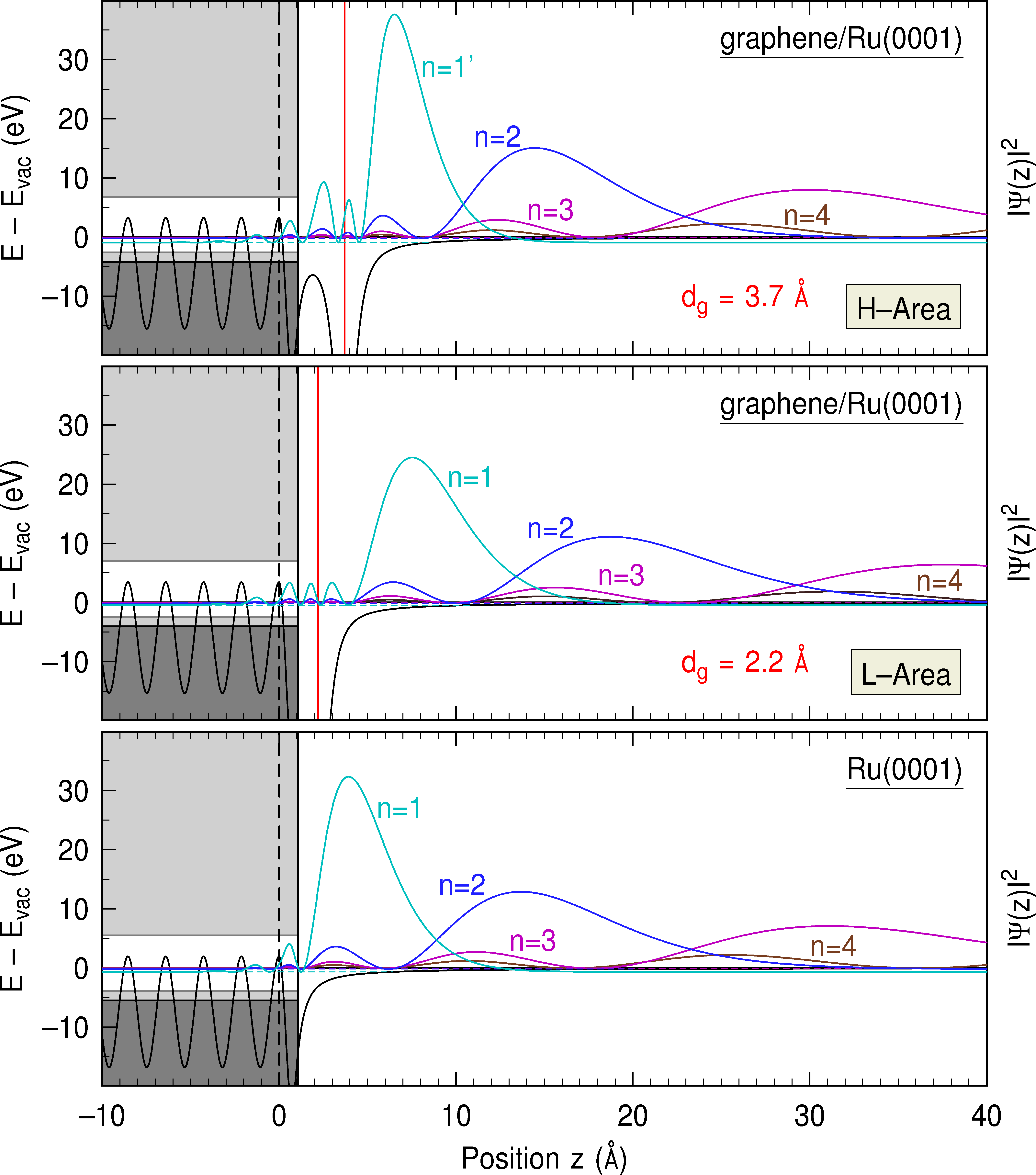Image Potential States
- Image Potential States at Metal Surfaces
- Time-Resolved Coherent Photoelectron Spectroscopy
- Inelastic and Quasielastic Scattering Processes
- Interface States at a Metal-Rare Gas Boundary
- Generation and Investigation of Ultrashort Electrical Currents
- Surface and Interface States of Periodically Rippled Graphene/Ru(0001)
Image Potential States at Metal Surfaces
Image-potential states are quantized electronic states that exist at metal surfaces with a band gap near the vacuum level. The Coulomb-like attractive image force, experienced by any charged particle in front of a conductive material, and the repulsive surface then form a potential well for weakly bound electrons. The energy levels in this potential are described by a Rydberg series similar to electrons in the hydrogen atom
En = -0.85 eV/(n+a)2, n = 1,2,…
Part A of the figure to the right shows a corresponding potential energy diagram for an electron in front of a Cu(100) surface. For this surface the sp-band gap in the direction perpendicular to the surface is particularly large and the image states are located almost in the middle of the band gap. The squares of the wave functions of the lowest three image states are also shown in this figure.
Experimentally, image-potential states are investigated with two-photon photoemission (2PPE). One photon excites an electron out of an occupied state below the Fermi energy into the image potential state n. A second photon excites the electron to an energy above the vacuum level. The electron leaves the surface and its kinetic energy is measured.
Image-potential states – because of their simplicity – provide an extremely useful model to study the relaxation behaviour of excited surface electronic states due to their interaction with the underlying substrate. This coupling in turn governs the cross section and branching ratios of practically all electronically induced adsorbate reactions at metal surfaces.
The figure below shows the results of direct time-domain experiments using 95 fs pump and 70 fs probe pulses for the 2PPE measurements.
Coherent Excitation of Image States
When sub-100-fs UV pulses are used for the excitation of image states their bandwidth becomes comparable or larger than the energy separation of the states of Rydberg series with quantum numbers n>4. The coherent excitation of several states leads to the observation of quantum beats in the 2PPE intensity. The coherent states resulting from the excitation of four or more image states form electron wavepackets that describe the quasiclassical periodic motion of weakly bound electrons in front of metal surfaces.
For more information click on the figure to the right or see:
U. Höfer et al., Science 277, 1480-82 (1997).
Literature
P. M. Echenique, J. B. Pendry,
The existence and detection of Rydberg states at surfaces,
J. Phys. C: Solid State Physics 11, 2065-2075 (1978).
Th. Fauster, W. Steinmann,
Two-photon photoemission spectroscopy of image states,
in Photonic Probes of Surfaces, P. Halevi, Ed. (Elsevier, Amsterdam, 1995), pp. 347-411.
I. L. Shumay, U. Höfer, Ch. Reuß, U. Thomann, W. Wallauer, Th. Fauster,
Lifetimes of image-potential states on Cu(100) and Ag(100) measured by femtosecond time-resolved two-photon photoemission,
Phys. Rev. B 58, 13974-13981 (1998).
P. M. Echenique, R. Berndt, E. V. Chulkov, Th. Fauster, A. Goldmann, U. Höfer,
Decay of electronic excitations at metal surfaces,
Surface Science Reports 52, 219-317 (2004).
Thomas Fauster, Martin Weinelt, Ulrich Höfer,
Quasi-elastic scattering of electrons in image-potential states,
Progr. Surf. Sci. 82, 224-243 (2007).
Time-Resolved Coherent Photoelectron Spectroscopy
Whereas most experimental methods record intensities and thus measure amplitudes of wave functions, coherent spectroscopies offer the unique capability of accessing also phase information. On ordered surfaces, the combination of time- and angle-resolved two-photon photoemission (2PPE) with coherent excitation allows one to completely determine the temporal evolution of the wave function of electronic states.
Electron Wave Packages

By exciting electrons into high-order image-potential states close to the vacuum level we have recently succeeded in creating electron wave packets at the surface of a metal. The calculated spatial and temporal evolution of such a wave packet is shown in the inset of the figure. It is a coherent superposition of several hydrogen-like wave functions in the vicinity of the quantum number n=7.

The dynamics of the wave packet resembles the classical motion of an electron  oscillating in the Coulomb-like image potential with a period of 800 fs. The maximum distance from the surface is ~200 A.
oscillating in the Coulomb-like image potential with a period of 800 fs. The maximum distance from the surface is ~200 A.
The perodic motion of the wave packet is detected by time-delayed probe pulse that photoemits the electron. The photoemission signal is clearly correlated with the probability of finding the electron close to the surface. Far away from the surface the electron is nearly free and cannot absorb a photon because both energy and momentum cannot be conserved in such a process. Near the surface the rapid gradient in the 1/z-potential provides such a source of momentum.
The figure to the right is schematic quasi-classical picture of the experiment. A pump pulse excites an electron from below the Fermi level of the metal into a region with no allowed states in the bulk. The electron moves away from the surface but its energy is not high enough to escape into the vacuum. The restoring image forced makes it move back to the metal where it is reflected from the repulsive surface barrier and continues its oscillatory motion.
Quantum Beat Spectroscopy
Also in cases without a dramatic spatial dynamics the exploitation of coherence effects in two-photon photoemission can provide very valuable information. An example is the resolution of closely spaced energy levels with quantum beat spectroscopy.
With increasing quantum number n the binding energy of image-potential states
En = -0.85 eV/(n+a)2
rapidly converges towards the vacuum level. Even with the best electron analysers it is difficult to resolve states with quantum numbers n>4. After coherent excitations the level spacing is clearly observable as oscillations (quantum beats) of the 2PPE signal as a function of pump-probe delay. In the example shown in the figure, the 95 fs pump pulse predominantly excites electrons into the n=4 and n=5 states. The beating period observed for short delay is 230 fs, corresponding to an energy difference E(5)-E(4) = 17.8 meV. After 2 ps most of the population in the n=4 state has decayed. The oscillations now reflect the interference of the amplitudes in the n=5 and the weakly excited n=6 state that persists at these delays. The beating period of 430 fs corresponds to a level spacing of 9.6 meV.
See also inelastic and quasielastic scattering processes and generation and investigation of ultrashort electrical currents.
Literature
U. Höfer, I. L. Shumay, Ch. Reuß, U. Thomann, W. Wallauer, Th. Fauster,
Time-resolved coherent photoelectron spectroscopy of quantized electronic states on metal surfaces,
Science 277, 1480-82 (1997).
E. W. Plummer,
More than skin deep,
Science 277, 1447-48 (1997).
Ch. Reuß, I. L. Shumay, U. Thomann, M. Kutschera, M. Weinelt, Th. Fauster, U. Höfer,
Control of the Dephasing of Image-Potential States by CO Adsorption on Cu(100),
Phys. Rev. Letters 82, 153-156 (1999).
U. Höfer,
Time-resolved coherent spectroscopy of surface states,
Appl. Phys. B 68, 383-392 (1999).
U. Höfer,
Dynamik von Bildpotentialzuständen,
in 31. IFF-Ferienkurs – Dynamik in kondensierter Materie (Forschungszentrum Jülich, 2000) F4.1-15.
Inelastic and Quasielastic Scattering Processes
Image-potential states provide a model system to study electron scattering at surfaces. With time-, energy- and angle-resolved two-photon photoemission quasi-elastic intraband and resonant interband scattering processes can be identified and resolved beside the inelastic electron-hole pair decay of image-potential electrons.
Inelastic Electron-Hole Pair Decay
The dynamics of electrons excited to image-potential states in a metal are predominantly governed by inelastic electron-electron scattering via screened Coulomb interaction. In first order, the inelastic lifetimes of image-potential states can be estimated by the so-called bulk penetration approximation. This model assumes that the lifetimes scale inversely to the probability density of the electron inside the metal. This approximation is motivated by the decay process, which is mediated by the interaction with the bulk electrons. It neglects the non-local character of the Coulomb interaction, which plays an important role at surfaces due to the reduced screening. It has been shown, however, that the non-local contributions to the total decay rate cancel each other to a large extent in favorable cases such as the Cu(100) surfaces. Therefore, the bulk penetration approximation may be used to estimate the change of the lifetimes in dependence on the quantum number. This leads to the conclusion that for higher image-states the inelastic lifetime should scale with the 3rd power of the quantum number.
Intraband Scattering
 For electrons at the bottom of the image-potential band (k||=0) of the Cu(100)-surface the only decay mechanism available is the (inelastic) interband decay to the bulk. Momentum-resolved investigation of the lifetimes of image-potential electrons exhibit that interband decay to the bulk significantly underestimates the experimentally observed momentum dependence. The increase of the decay rate with parallel momentum is to a remarkably large extent (approximately 50%) determined by a second decay channel that is available to electrons with finite parallel momentum. In this process of intraband scattering, the electrons remain inside the image-state band but change their momentum and relax towards the band minimum.
For electrons at the bottom of the image-potential band (k||=0) of the Cu(100)-surface the only decay mechanism available is the (inelastic) interband decay to the bulk. Momentum-resolved investigation of the lifetimes of image-potential electrons exhibit that interband decay to the bulk significantly underestimates the experimentally observed momentum dependence. The increase of the decay rate with parallel momentum is to a remarkably large extent (approximately 50%) determined by a second decay channel that is available to electrons with finite parallel momentum. In this process of intraband scattering, the electrons remain inside the image-state band but change their momentum and relax towards the band minimum.
Resonant Interband Scattering
A characteristic feature of image-potential states is the existence of an infinite series of states converging towards the vacuum level. In each state the electron can move freely parallel to the surface. The resulting energy bands do not intersect on a flat surface. Although the coupling between different image-potential bands is not seen in the energy dispersion it can be observed in time-resolved experiments. Pump-probe traces of the clean Cu(100)-surface taken for photon energies above the threshold for excitation of the n=2 image-potential band show a biexponential decay. The short timescale corresponds to the lifetime of the n=1 state, whereas the longer timescale matches the value obtained for the n=2 state around k||=0. The obvious explanation for these findings is the scattering of electrons from the n=2 state to the n=1 band as indicated by process C in the figure below. Because the lifetime of the n=2 state is significantly longer than that of the n=1 state, the scattered electrons are seen after the initial population of the n=1 band has decayed. The long-lived feature disappears when the photon energy of the pump pulse is not sufficient to excite the n=2 state. This slowly decaying component is resonantly enhanced when n=2 and n=1 become energetically degenerate. For these reasons this new relaxation process is called resonant interband scattering (RIS).
Dephasing of Quantum-Beats
 Defects are a major source for quasi-elastic scattering at surfaces. They interrupt the periodicity of the surface and quasi-free-electron motion of the electrons parallel to the surface is disturbed. The simplest process would be elastic scattering by the defect. This changes the direction but not the energy of the electron in the image-potential state as indicated by process B in the figure below. Early energy-resolved two-photon photoelectron spectroscopy observed already an increase of the linewidth of image-potential states with adsorbate coverage for several systems. However, these studies could not distinguish between inelastic decay and quasi-elastic scattering-induced by the adsorbates. The combination with time-resolved measurements is needed to separate the different processes for image-potential states. In the quantum-beat spectroscopy of the n=3 and 4 image-potential states of the Cu(100)-surface the decay of the population is caused by inelastic scattering, whereas the oscillations are dampened in addition also by quasi-elastic scattering events which change the temporal phase of the wave functions. The figure on the right side shows that CO has almost no influence on the lifetime, but destroys the oscillations very effectively.
Defects are a major source for quasi-elastic scattering at surfaces. They interrupt the periodicity of the surface and quasi-free-electron motion of the electrons parallel to the surface is disturbed. The simplest process would be elastic scattering by the defect. This changes the direction but not the energy of the electron in the image-potential state as indicated by process B in the figure below. Early energy-resolved two-photon photoelectron spectroscopy observed already an increase of the linewidth of image-potential states with adsorbate coverage for several systems. However, these studies could not distinguish between inelastic decay and quasi-elastic scattering-induced by the adsorbates. The combination with time-resolved measurements is needed to separate the different processes for image-potential states. In the quantum-beat spectroscopy of the n=3 and 4 image-potential states of the Cu(100)-surface the decay of the population is caused by inelastic scattering, whereas the oscillations are dampened in addition also by quasi-elastic scattering events which change the temporal phase of the wave functions. The figure on the right side shows that CO has almost no influence on the lifetime, but destroys the oscillations very effectively.
Summary

Inelastic as well as quasielastic scattering processes are important at any surface for any electronic state. Image-potential states provide a unique model system to study the various scattering processes in detail with the available experimental capabilities. Possible processes are illustrated in the figure below as referred to in the text above for particles in real space and more accurately for electronic states in an energy diagram.
Literature
C. Reuss, I. L. Shumay, U. Thomann, M. Kutschera, M. Weinelt, T. Fauster, U. Höfer,
Control of the Dephasing of Image-Potential States by CO Adsorption on Cu(100),
Phys. Rev. Lett. 82, 153-156 (1999).
W. Berthold, J. Güdde, P. Feulner, U. Höfer,
Resonant Interband Scattering of Image-Potential States,
Appl. Phys. B 73, 865-868 (2001).
W. Berthold, U. Höfer, P. Feulner, E. V. Chulkov, V. M. Silkin, P. M. Echenique,
Momentum-Resolved Lifetimes of Image-Potential States on Cu(100),
Phys. Rev. Lett. 88, 056805 (2002).
P. M. Echenique, R. Berndt, E. V. Chulkov, Th. Fauster, A. Goldmann, U. Höfer,
Decay of electronic excitations at metal surfaces,
Surface Science Reports 52, 219-317 (2004).
Thomas Fauster, Martin Weinelt, Ulrich Höfer,
Quasi-elastic scattering of electrons in image-potential states,
Progr. Surf. Sci. 82, 224-243 (2007).
Interface States at a Metal-Rare Gas Boundary
In the last few years, several groups have used time- and angle-resolved two-photon photoemission to study the dynamics of image-potential states at clean and adsorbate covered metal surfaces. Recently, we have shown for the system Ar/Cu(100) that similar electronic states exist at the boundary between a metal and an insulator. In bulk Ar, the lowest energy of an excess electron would be the conduction band minimum located 0.25 eV above the vacuum level. Close to the metal interface, such an excited electron is attracted towards the metal by image forces while the projected band gap of the Cu(100) crystal hinders it from penetrating into the metal (see figure above). Analogous to the case of image-potential states on clean surfaces, this gives rise to an infinite series of electronic states located at the Ar/Cu interface with energies
En‘ = ECBM – 0.85 eV / (n‘+a)2 × m eff / ε2, n‘=1, 2, …
where n‘ denotes the quantum number and a the quantum defect. Compared to the usual series of image-potential states that converge towards the vacuum level, the reference level for the Ar/Cu interface states is the Ar affinity level or the conduction band minimum ECBM=0.25 eV. The binding energy of the interface states with respect to ECBM is lowered by a factor meff/ε2 because the image potential is screened by the Ar overlayer with its dielectric constant ε and because the potential is periodically modulated by the Ar atoms which leads to an effective electron mass meff×m0, where m0 is the mass of the free electron. We have shown that interface states can be studied with time-resolved 2PPE even if they are buried under Ar layers as thick as 10 nm. After a pump pulse has populated the interface states with an electron from the metal, the probe pulse promotes the electrons into the Ar conduction band from where it escapes to the vacuum by ballistic transport through the layer.

The dynamics of electrons located at buried solid-solid interfaces is not only of vast technological significance but also of great fundamental importance. Interesting issues are, e.g., the elastic or quasi-elastic transfer of electrons across the boundary of two materials with different geometric and electronic structure or the dynamical many-body response of interface electrons leading to inelastic decay. Buried image-potential states such as those in Ar/Cu provide a simple model to address these problems. As we have shown by experiments using Ar films of varying thickness, the lifetimes of electrons excited into the Ar/Cu interface states are limited by two distinct decay channels: inelastic decay by electron-hole pair (e-h) excitation in the metal and by elastic tunnelling through the Ar layer. This second channel is a consequence of the negative electron affinity of Ar which results in En‘ > 0, i.e. in the language of atomic physics the states are autoionizing resonances.

The figure above shows an two-dimensional energy spectrum for 25 ML Ar/Cu(100). To see a movie of two-dimensional spectra at variing delays between the exciting and photoemitting laser pulses together with the pump-probe traces of the first quasi-bound interface state click on the on the link provided here or on the figure above. Further information about the investiagation of interface states can be found in the references listed below.
Literature
M. Rohleder, W. Berthold, J. Güdde, U. Höfer,
Time-Resolved Two-Photon Photoemission of Buried Interface States in Ar/Cu(100),
Phys. Rev. Lett. 94, 017401 (2005).
M. Rohleder, K. Duncker, W. Berthold, J. Güdde, U. Höfer,
Momentum-resolved dynamics of Ar/Cu(100) interface states probed by time-resolved two-photon photoemission,
New Journal of Physics 7, 103 (2005).
Generation and Investigation of Ultrashort Electrical Currents
Using modern optical techniques, researchers from the Department of Physics of the Philipps-University of Marburg succeeded in generating and investigating electrical current pulses which are more than thousand times shortes as can be measured by the fastest available electronics. These ultrashort current pulses were generated by irradiation of metal surfaces with femtosecond laser pulses (1 femtosecond = 1 fs = 0.000 000 000 000 001 seconds) Due to their short duration these current pulses make it possible to study fundamental mechanisms of the interaction of electrons in solids. In particular, it was for the first time possible to observe the ultrafast temporal evolution of microscopical processes that are responsible for the electrical resistance of solids (SCIENCE, November 23, 2007).

Reference
J. Güdde, M. Rohleder, T. Meier, S.W. Koch, U. Höfer,
Time-Resolved investigation of coherently controlled electric currents at a metal surface,
Science 318, 1287 (2007)
Surface and Interface States of Periodically Rippled Graphene/Ru(0001)
 There is fast-growing interest in understanding the interaction of graphene with metal substrates. By means of thermal decomposition of unsaturated hydrocarbon species on transition metal substrates, the fabrication of very large and extremely well-defined graphene sheets can be realized. Moreover, metal contacts are of high relevance to graphene-based electronic devices. In terms of the electronic structure, angle-resolved photoelectron spectroscopy has already provided information about the occupied states of graphene on different substrates. Comparatively little, however, is known about unoccupied states above the Fermi level and even less on dynamics of electron transfer processes between graphene layers and metals.
There is fast-growing interest in understanding the interaction of graphene with metal substrates. By means of thermal decomposition of unsaturated hydrocarbon species on transition metal substrates, the fabrication of very large and extremely well-defined graphene sheets can be realized. Moreover, metal contacts are of high relevance to graphene-based electronic devices. In terms of the electronic structure, angle-resolved photoelectron spectroscopy has already provided information about the occupied states of graphene on different substrates. Comparatively little, however, is known about unoccupied states above the Fermi level and even less on dynamics of electron transfer processes between graphene layers and metals.
In our study we explored the unoccupied electronic states of epitaxially grown graphene on Ru(0001) by time-, energy- and angle-resolved two-photon photoemission. We identify a Ruthenium derived resonance and a graphene/Ruthenium interface state at 0.91 and 2.58 eV above the Fermi level, as well as three image-potential derived states close to the vacuum level. The most strongly bound, short-lived, and least dispersing imagepotential state is suggested to have some quantum-well character with a large amplitude below the graphene hills. The two other image-potential states are attributed to a series of slightly decoupled states. Their lifetimes and dispersions are indicative of electrons moving almost freely above the valley areas of the moiré superlattice of graphene.
Image-potential State of Freestanding Graphene
The possibility to fabricate freestanding Graphene, a single atomic layer of graphite, has raised interesting questions with regard to its surface electronic structure. Due to the fact that this system exhibits a mirror plane with in fact two surfaces, the eigenstates of this system must be either a symmetric or antisymmetric superposition of the electronic states of each surface. This applies also to image-potential states, a class of intrinsic surface states that exist at all solid surfaces due to the interaction of an electron in the vacuum with the polarizable surface. This interaction can be described by the classical image-potential which gives rise to a hydrogen-like Rydberg series of electronic surface states with binding energies Consequently, it has been predicted that freestanding graphene should possess a double Rydberg-like series of image-potential states of even and odd symmetry:
![]()
Here, a± denotes the quatum defect of the even and the odd states, respectively. However, there are so far no experiments on freestanding graphene that provide clear evidence for these two series.
The Graphene/Ru(0001) Interface
The focus of the experiment is the question how the surface states of graphene and those of a clean metal substrate evolve to a common interfacial electronic structure when both are brought into close contact. As shown for serveral organic/metal interfaces, the properties of interface states strongly depend on the adsorption height of the specific organic molecule. Thus, an exceptional interesting species of a thin single layer of graphene on a metal substrates is given by graphene/Ru(0001). Due to the strong bonding of the graphene to the substrate, the relative large latice missmatch results in a strong rippling of the graphene. This leads to a hexagonal 25×25 moiré superlatice of the graphene whose carbon atoms are bound covalently to the Ruthenium atom in the valleys (L-areas) with an adsorption heigth of 2.2 Å and rather physisorped in the hills (H-areas) with an adsorption heigth of 3.7 Å.
Since the unoccupied electronic structure of graphene/Ru(0001) is postioned energetically between the Fermi-level and the vacuum niveau, we employ the time-, energy- and angle-resolved two-photon photoemission experimental setup to gain information on the binding energies, ultrafast dynamics an lateral localization of the electronic states.
Binding Energies
The two-photon photoemission spectrum of graphene/Ru(0001) holds a multiplicity of spectral features. The comparison of the spectrum only taken with the pump- or the probe laser beam with the combination of both as well as the choice of their photon energies enables us to identify these features unambigously.
We observe the first members n=1, 2 and n=1′ of two independent series of image-potential states which at first glance may be attributed to the even and odd double series predicted for freestanding graphene. Actually these can be identified as two single series of lower and higher binding energies with respect to the different local work functions which are located in the L-areas and the H-areas, respectively. The reduction from a double to a single Rydberg-like series can be attribued to the symmetry braek due to the presence of the metal substrate.
Additionally we observe, that the confinement in the L-Areas shifts up the surface resonance S‚ of Ru(0001) in energy with respect to the Fermi level where it forms a new interfacial state S due to hybridizaton with the first image potential state while in the H-areas it is not modified.
Dispersion
The conducted angle-resolved two-photon photoemission spectroscopy is able to reveal the energy-dispersion of the initially unoccupied surface states with respect to the electron’s momentum k|| parallel to the surface.
The image-potential states as well as the surface resonance and the interfacial state clearly show a parabolic dispersion within surface projected band structure. Since the electrons in these states are able to move freely along the surface the exhibit an effective mass meff near unity except the image-potential state n=1′. In comparison to the more connected L-areas the later state is more localized within the seperated H-areas which is indicated by its larger effective mass of meff = 2.
The strong corrugation of the graphene sheet also has a major impact on the surface band structure: All states show a remarkable backfolding at the surface Brilloiun zone boundaries of the moiré superlattice.
Dynamics
The ultrafast electron dynamics of the image-potential states as well as of the the surface resonance and the interfacial state can be accessed by a systematic variation of the time dealy between the pump- and the probe laser beam.
The decay dynamics reveal that in the L-areas the epitaxial graphene sheet decouples the image-potential states n=1 and n=2 from the metal substrate what expresses in sligthly longer ineleastic lifetimes compared to the pristine Ru(0001) surface. In contrast in the H-areas the inelastic lifetime of the (n=1′)-state is similar to the pristine Ru(0001) surface what indicates a high elctronic coupling to the substrate and therefore a high probability density near the metal surface.
Due to the fact that the surface resonance S‚ as well as the the interfacial state S are intrisically more located at the metal surface than the image-potential states are, the lower inelastic lifetime of the interfacial state than the surface resonance is a result of the enhanced phase space at its energetic position with respect to the Fermi-level.
Modellation
The theoretical modellation of graphene/Ru(0001) enables us to obtaine detailed information on the properties of the image-potential states at interface. Due to the comparably large dimension of its lateral structurization graphene/Ru(0001) can be modelled as a simple one-dimensional potential perpendicular to the suface with bonding distances d that corresponds to the L– and H-areas. Thus, we are able to investigate the formation of the image-potential states of the graphene-Ru(0001) interface by systematically tuning d. The eigenvalues of the image potential states are obtained by numerically solving the Schrödinger-equation.
For large distances d (graphene and Ru(0001) are totally separated), the wave functions of the image-potential states of the graphene are like found for freestanding graphene, while Ru(0001) at the Ru(0001) there is now Rydberg-like seies due to the large differnce in work function. By reducing d the image-potential states are modified by the symmetry break due to the presence of the metal substrate in the order corresponding to their spacial extend from high to low quantum number n. This results in a reduction of their binding energy with respect to the vacuum level as well as a phase shift of their Wavefunction relativ to the graphene plane.
This mechnism eventually reduces the double Rydberg-like series of image-potential states of freestanding grafphene to a single d-depending series at the graphene/Ru(0001) interface. In the L-areas this series resembles this of the prisine Ru(0001) with an slight degree of decoupling as found experimentally. In the H-areas a certain portion of the probability density slips unter the graphen sheet which enhances the observed elctronic coupling the substrate.
Literature
- N. Armbrust, J. Güdde, and U. Höfer
Formation of Image-Potential States at the Graphene/Metal Interface,
New J. Phys. 17 ,103043 (2015). DOI: 10.1088/1367-2630/17/10/103043 - N. Armbrust, J. Güdde, P. Jakob, and U. Höfer,
Time-Resolved Two-Photon Photoemission of Unoccupied Electronic States of Periodically Rippled Graphene on Ru(0001),
Phys. Rev. Lett. 108, 056801 (2012). DOI: 10.1103/PhysRevLett.108.056801
